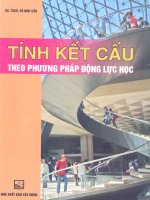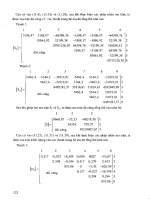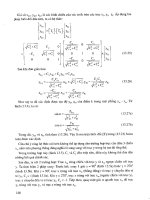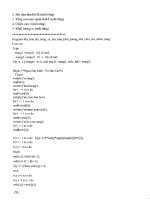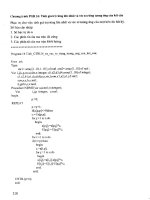Phân tích kết cấu theo phương pháp strut and tie model
Bạn đang xem bản rút gọn của tài liệu. Xem và tải ngay bản đầy đủ của tài liệu tại đây (3.63 MB, 67 trang )
THE STRUT-AND-TIE MODEL
OF CONCRETE STRUCTURES
By
Dr. C. C. Fu, Ph.D., P.E,
The BEST Center
University of Maryland
Presented to
The Maryland State Highway Administration
August 21, 2001
Introduction
The Strut-and-Tie is a unified approach that
considers all load effects (M, N, V, T)
simultaneously
The Strut-and-Tie model approach evolves as one
of the most useful design methods for shear critical
structures and for other disturbed regions in
concrete structures
The model provides a rational approach by
representing a complex structural member with an
appropriate simplified truss models
There is no single, unique STM for most design
situations encountered. There are, however, some
techniques and rules, which help the designer,
develop an appropriate model
History and Specifications
The subject was presented by Schlaich et al
(1987) and also contained in the texts by
Collins and Mitchell (1991) and MacGregor
(1992)
One form of the STM has been introduced in
the new AASHTO LRFD Specifications (1994),
which is its first appearance in a design
specification in the US
It will be included in ACI 318-02 Appendix A
Bernoulli Hypothesis
Bernoulli hypothesis states that: " Plane
section remain plane after bending…"
Bernoulli's hypothesis facilitates the flexural
design of reinforced concrete structures by
allowing a linear strain distribution for all
loading stages, including ultimate flexural
capacity
N.A.
St. Venant’s Principle
St. Venant's Principle states that: " The
localized effects caused by any load
acting on the body will dissipate or
smooth out within regions that are
sufficiently away from the location of the
load…"
B- & DRegions
for
Various
Types of
Members
Design of B & D Regions
The design of B (Bernoulli or Beam) region is
well understood and the entire flexural
behavior can be predicted by simple
calculation
Even for the most recurrent cases of D
(Disturbed or Discontinuity) regions (such as
deep beams or corbels), engineers' ability to
predict capacity is either poor (empirical) or
requires substantial computation effort (finite
element analysis) to reach an accurate
estimation of capacity
STM
for
Simple
Span
Beam
Feasible Inclined Angle θ
Swiss Code: 0.5 ≤ Cot θ ≤ 2.0 (θ=26° to 64°)
European Code: 3/5 ≤ Cot θ ≤ 5/3 (θ=31° to 59°)
Collin’s & Mitchells
θmin = 10 + 110(Vu/[φfc′bwjd]) deg
θmax = 90 - θmin deg
ACI 2002: θmin =25°; (25° ≤ θrecom ≤ 65° here)
If small θ is assumed in the truss model, the
compression strength of the inclined strut is
decreased.
STM of a Deep Beam
ACI Section 10.7.1 For Deep Beam:
L/d < 5/2 for continuous span; < 5/4 for simple span
ACI Section 11.8: L/d <5 (Shear requirement)
Deep
Beam
Stress
and Its
STM
Model
Transition
from Deep Beam to Beam
STM Model
for a
Two-span
Continuous
Beam
Basic Concepts
Strut-and-Tie Model: A conceptual framework
where the stress distribution in a structure is
idealized as a system of
Strut
Compression Concrete
Member
Tie or Tension
Stirrup Member
Reinforcement
Node
Concrete
Connection
Examples of STM Models
Strut Angle of STM Model
A STM developed with struts parallel to the
orientation of initial cracking will behave very well
A truss formulated in this manner also will make the
most efficient use of the concrete because the
ultimate mechanism does not require reorientation of
the struts
Lower Bound Theorem
of Plasticity
A stress field that satisfies equilibrium
and does not violate yield criteria at any
point provides a lower-bound estimate
of capacity of elastic-perfectly plastic
materials
For this to be true, crushing of concrete
(struts and nodes) does not occur prior
to yielding of reinforcement (ties or
stirrups)
Limitation of The Truss Analogy
The theoretical basis of the truss analogy is
the lower bound theorem of plasticity
However, concrete has a limited capacity to
sustain plastic deformation and is not an
elastic-perfectly plastic material
AASHTO LRFD Specifications adopted the
compression theory to limit the compressive
stress for struts with the consideration of the
condition of the compressed concrete at
ultimate
Prerequisites
Equilibrium must be maintained
Tension in concrete is neglected
Forces in struts and ties are uni-axial
External forces apply at nodes
Prestressing is treated as a load
Detailing for adequate anchorage
Problems
in STM Applications
1.How to construct a Strut-and-Tie
model?
2.If a truss can be formulated, is it
adequate or is there a better one?
3.If there are two or more trusses for the
same structure, which one is better?
Struts
A. Compression struts fulfill two functions in
the STM:
1. They serve as the compression chord of
the truss mechanism which resists
moment
2. They serve as the diagonal struts which
transfer shear to the supports
B. Diagonal struts are generally oriented
parallel to the expected axis of cracking
Types of Struts
There are three types of struts that will be
discussed:
1. The simplest type is the “prism” which has a
constant width
2. The second form is the “bottle” in which the
strut expands or contracts along its length
3. The final type is the “fan” where an array of
struts with varying inclination meet at or
radiate from a single node
Three Types of Struts
Compression Struts
Ties
Tensions ties include stirrups, longitudinal
(tension chord) reinforcement, and any
special detail reinforcement
A critical consideration in the detailing of the
STM is the provision of adequate anchorage
for the reinforcement
If adequate development is not provided, a
brittle anchorage failure would be likely at a
load below the anticipated ultimate capacity




